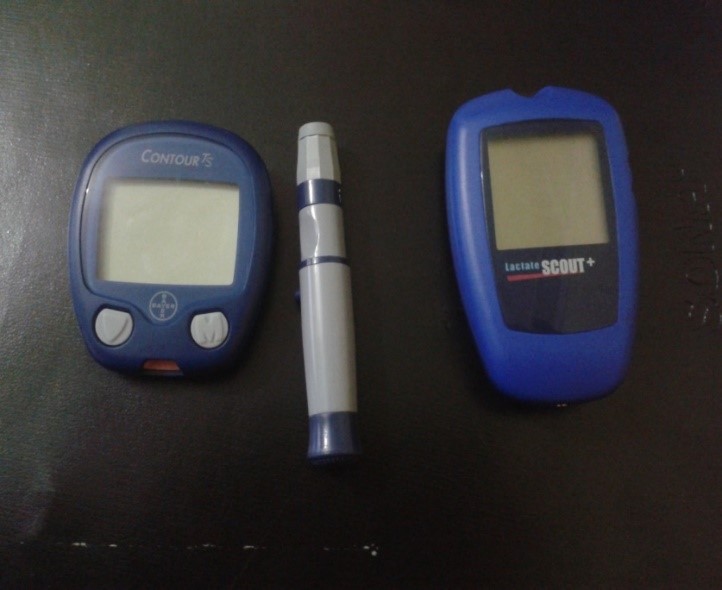Simultaneous Electrical Stimulation of Multiple Muscles Reduces Blood Glucose Level in Healthy Adults
Main Article Content
Abstract
Aim & Objective: The aim of this study was to examine the effects of 30-minute simultaneous stimulation using Russian current on selected physiological parameters in a pretest posttest experimental design.
Methods: 10 healthy male sports players aged 18-24 years were selected & given stimulation over 8 large muscles using Russian current of frequency 25100 Hertz (Hz) sweep 50 Hz. Heart rate, Respiratory rate, blood pressure, oral temperature, Blood glucose and Blood lactate were recorded at pre-stimulation, immediately after stimulation and at 5 minute and 20 minutes post stimulation phase.
Results: One-way repeated measure ANOVA with post hoc t test was the tool of statistical analysis with level of significance set at p < 0.05. Significant differences were observed in the parameters of blood glucose and blood lactate level only. Mean blood glucose level pre stimulation, immediately post stimulation, 5-minute post stimulation and 20-minute post stimulation were 99.00 ±17.15, 81.80±15.74, 89.10±17.56 and 93.90 ± 18.15 respectively. The corresponding figures for blood lactate were 2.83±0.80, 6.19± 3.61, 4.60±1.60 and 3.97±1.75. Significant difference was found between the blood glucose and blood lactate level (p<0.05) only between pre stimulation and immediate post stimulation period.
Conclusion: It can be concluded that simultaneous electrical stimulation of 8 large muscles for 30 minutes using Russian currents brings about a drop in blood glucose level along with elevation of blood lactate without significantly affecting heart rate, blood pressure and oral temperature in healthy young adults. This hints at the possibility of using this modality as tool to achieve glycemic control.
Article Details
References
Astrand, P.O., Rodahl, K., Dahl, H.A., Stromme, S.B. (2003). Textbook of Work Physiology 4th Ed. Human Kinetics; 237-72.
Cramp, F.L., McCullough, G.R., Lowe, A.S., Walsh, D.M. (2002). Transcutaneous electric nerve stimulation: the effect of intensity on local and distal cutaneous blood flow and skin temperature in healthy subjects. Arch. Phys. Med. Rehabil; 83:5–9.
Crowe, L., Caulfield, B. (2012). Aerobic neuromuscular electrical stimulation -an emerging technology to improve hemoglobin A1c in type 2 diabetes mellitus: results of a pilot study. BMJ Open; 2: e000219
DeFronzo, R.A. (1988). The triumvirate: beta-cell, muscle, liver. A collusion responsible for NIDDM. Diabetes; 37: 667-687.
Esen, B., Jansson, E., Henricksson, E., Taylor, A.W., Saltin, B. (1975). Metabolic characteristics of fiber types in human skeletal muscles. Acta Physiol. Stand; 95: 153-165.
Goodyear, L.J., King, P.A., Hirshman, M.F., Thompson, C.M., Horton, E.D., Horton, E.S. (1990). Contractile activity increases plasma membrane glucose transporters in absence of insulin. Am J Physiol Endocrinol Metab; 258: E667–E672.
Griffin, L., Decker, M.J., Hwang, J.Y., Wang, B., Kitchen, K.., Ding, Z., Ivy, J.L. (2009). Functional electrical stimulation cycling improves body composition, metabolic and neural factors in persons with spinal cord injury. Journal of Electromyography and Kinesiology; 19: 614-622.
Hamada, T., Sasaki, H., Hayashi, T., Moritani, T., Nakao, K. (2003). Enhancement of whole-body glucose uptake during and after human skeletal muscle low-frequency electrical stimulation. J Appl Physiol; 94(6):2107-12.
Hamada, T., Hayashi, T., Kimura, T., Nakao, K., Moritani, T. (2004). Electrical stimulation of human lower extremities enhances energy consumption, carbohydrate oxidation, and whole-body glucose uptake. J Appl Physiol; 96(3):911-6.
Henning, R., Lomo, T. (1985). Firing patterns of motor units in normal rats. Nature; 314: 164–166.
Hultman, E., Sjoholm, H. (1983). Energy Metabolism and Contraction Force of Human Skeletal Muscle in Situ During Electrical Stimulation. J. Physiol; 345: 525-532
Kawaguchi, T., Shiba, N., Takano, Y., Maeda, T., Sata, M. (2011). Hybrid training of voluntary and electrical muscle contractions decreased fasting blood glucose and serum interleukin-6 levels in elderly people: a pilot study. Appl Physiol Nutr Metab; 36(2):276-83.
Lund, S., Holman, G.D., Schmitz, O., Pedersen, O. (1995). Contraction stimulates translocation of glucose transporter GLUT4 in skeletal muscle through a mechanism distinct from that of insulin. Proc Natl Acad Sci USA; 92: 5817–5821.
Miyamoto, T., Fukuda, K., Kimura, T., Matsubara, Y., Tsuda, K., Moritani. (2012). Effect of percutaneous electrical muscle stimulation on postprandial hyperglycemia in type 2 diabetes. Diabetes Res Clin Pract; 96(3):306-12.
Ploug, T., Galbo, H., Richter, E.A. (1984). Increased muscle glucose uptake during contractions: no need for insulin. Am J Physiol Endocrinol Metab; 247: E726–E731.
Porcari, J.P., Mclean, K.P., Foster, C., Kernozek, T., Crenshaw, B., Swenson, C. (2002). Effects of Electrical Muscle Stimulation on Body Composition, Muscle Strength, and Physical Appearance. Journal of Strength and Conditioning Research; 16(2), 165–172.
Ren, J.M., Broberg, S., Sahlin, K., Hultman, E. (1990). Influence of reduced glycogen level on glycogenolysis during short-term stimulation in man. Acta Physiol Scand; 139:467–474.
Selkowitz, D.M. (1989). High frequency electrical stimulation in muscle strengthening. Am J Sports Med; 17:103– 111.
Sharma, D., Shenoy, S., Singh, J. (2010). The effect of electrical stimulation on blood glucose and lipid profile of sedentary type 2 diabetic patients. International Journal of Diabetes in Developing Countries; 30(4): 194-200
Sinacore, D.R., Delitto, A., King, D.S., Rose, S.J. (1990). Type II fiber activation with electrical stimulation: a preliminary report. Phys Ther; 70: 416–422.
Smith, P.C., Susan, M., Schmidt, B.A., Allensworth, D.D., Saitz, R. (2010). A Single-Question Screening Test for Drug Use in Primary Care. Arch Intern Med; 170(13):1155-1160.
Wallberg, H., Holloszy, J.O. (1984). Contractile activity increases glucose uptake by muscle in severely diabetic rats. J Appl Physiol; 57: 1045–1049.

